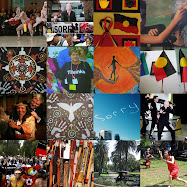

Captain James Cook sailed the Barque Endeavour into Botany Bay and made landfall here, at Kurnell, on Sunday April 29, 1770, claimed the land for the British Empire, and spent 8 days at anchor. He and his crew never made camp, but stayed on the boat to sleep. Botanists, most notably, Joseph Banks, collected plants, and wildlife was observed. Fresh water was found in a little stream. Cook named the bay Stingray Harbour ( from sightings of stingrays), and it subsequently became known as Botany Bay, after the botanic specimens collected. Eighteen years later, the First Fleet, led by Arthur Phillip, turned up at Botany Bay, looking to establish a British penal colony. Phillip found the fresh water supply inadequate, and the sandy soil unsuitable, so set sail a little further north to explore Port Jackson, which Cook named, but didn't enter.

The
top photo shows the marker on the honeycomb weathered sandstone rocks where Cook's landing party set foot. The
second photo is the replica boat Endeavour at anchor in Botany Bay.
Right, marker and ship.

 Captain James Cook sailed the Barque Endeavour into Botany Bay and made landfall here, at Kurnell, on Sunday April 29, 1770, claimed the land for the British Empire, and spent 8 days at anchor. He and his crew never made camp, but stayed on the boat to sleep. Botanists, most notably, Joseph Banks, collected plants, and wildlife was observed. Fresh water was found in a little stream. Cook named the bay Stingray Harbour ( from sightings of stingrays), and it subsequently became known as Botany Bay, after the botanic specimens collected. Eighteen years later, the First Fleet, led by Arthur Phillip, turned up at Botany Bay, looking to establish a British penal colony. Phillip found the fresh water supply inadequate, and the sandy soil unsuitable, so set sail a little further north to explore Port Jackson, which Cook named, but didn't enter.
Captain James Cook sailed the Barque Endeavour into Botany Bay and made landfall here, at Kurnell, on Sunday April 29, 1770, claimed the land for the British Empire, and spent 8 days at anchor. He and his crew never made camp, but stayed on the boat to sleep. Botanists, most notably, Joseph Banks, collected plants, and wildlife was observed. Fresh water was found in a little stream. Cook named the bay Stingray Harbour ( from sightings of stingrays), and it subsequently became known as Botany Bay, after the botanic specimens collected. Eighteen years later, the First Fleet, led by Arthur Phillip, turned up at Botany Bay, looking to establish a British penal colony. Phillip found the fresh water supply inadequate, and the sandy soil unsuitable, so set sail a little further north to explore Port Jackson, which Cook named, but didn't enter. The top photo shows the marker on the honeycomb weathered sandstone rocks where Cook's landing party set foot. The second photo is the replica boat Endeavour at anchor in Botany Bay. Right, marker and ship.
The top photo shows the marker on the honeycomb weathered sandstone rocks where Cook's landing party set foot. The second photo is the replica boat Endeavour at anchor in Botany Bay. Right, marker and ship.




From Aborigines to British settlers, I love your sandstones series, Sally. Well documented and fascinating to read, as always. And your sandstone shots just send me right there with you.
ReplyDeleteThere's a large fish engraving near Tamarama, along the coastal walk to Bondi. Is that an original Aboriginal drawing?
Sandstones are wonderful, and I love a feeling of touching history, aroused by your photos.
ReplyDeleteAustralia has the most unique history! The land is so old and the country is so new.
ReplyDeleteYep - I agree. This sandstone series is taking me places I never expected to go. I like the main image with the pot holes. My joy as a child (long time ago!) was to go from pot to pot looking for urchins etc.
ReplyDelete